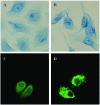Differential expression and regulation of prohibitin during curcumin-induced apoptosis of immortalized human epidermal HaCaT cells
- PMID: 24402549
- PMCID: PMC3926502
- DOI: 10.3892/ijmm.2014.1621
Differential expression and regulation of prohibitin during curcumin-induced apoptosis of immortalized human epidermal HaCaT cells
Abstract
Prohibitin (PHB), also known as inhibin, is important in cell proliferation, differentiation and apoptosis. This protein localizes to the inner membrane of mitochondria, where it acts as a chaperone protein, and is also found in the nucleus, where it negatively regulates transcription. The tumor-suppressive role of PHB in cell proliferation appears to be contradictory. In this study, we investigated the existence, localization and alterations in the expression of PHB in the whole cell and nuclear matrix and analyzed its co-localization with the expression products of related genes. The western blot analysis results revealed that PHB exists in the composition of nuclear matrix proteins and that the expression level of PHB is significantly increased in the whole cell and markedly decreased in the nuclear matrix after curcumin (1,7-bis(4-hydroxy-3-methoxyphenyl)-1,6-heptadiene-3,5-dione) treatment. The laser confocal scanning microscope results demonstrated the co-localization of PHB with p53, c-Myc, Bax, and Fas in HaCaT cells, and this co-localization region was transferred as a result of curcumin treatment. In addition, the results of the GST pull-down assay demonstrated the direct interaction of PHB with p53, c-Myc and Bax but not Fas in vitro. Results of the present study confirmed that the expression and distribution of PHB, which is a nuclear matrix protein, affect the apoptosis of HaCaT cells and its co-localization with specific gene products connected with cell apoptosis.
Figures







Similar articles
-
Positional and expressive alteration of prohibitin during the induced differentiation of human hepatocarcinoma SMMC-7721 cells.World J Gastroenterol. 2008 Aug 28;14(32):5008-14. doi: 10.3748/wjg.14.5008. World J Gastroenterol. 2008. PMID: 18763282 Free PMC article.
-
Localization of prohibitin in the nuclear matrix and alteration of its expression during differentiation of human neuroblastoma SK-N-SH cells induced by retinoic acid.Cell Mol Neurobiol. 2011 Mar;31(2):203-11. doi: 10.1007/s10571-010-9608-7. Cell Mol Neurobiol. 2011. PMID: 21061155 Free PMC article.
-
[Localization of prohibitin in nuclear matrix and its expressive alteration during the differentiation of human osteosarcoma MG-63 cells induced by HMBA].Fen Zi Xi Bao Sheng Wu Xue Bao. 2008 Feb;41(1):1-10. Fen Zi Xi Bao Sheng Wu Xue Bao. 2008. PMID: 18464584 Chinese.
-
The aberrant expression and localization of prohibitin during apoptosis of human cholangiocarcinoma Mz-ChA-1 cells.FEBS Lett. 2014 Jan 31;588(3):422-8. doi: 10.1016/j.febslet.2013.12.021. Epub 2013 Dec 28. FEBS Lett. 2014. PMID: 24380853
-
Prohibitin( PHB) roles in granulosa cell physiology.Cell Tissue Res. 2016 Jan;363(1):19-29. doi: 10.1007/s00441-015-2302-9. Cell Tissue Res. 2016. PMID: 26496733 Free PMC article. Review.
Cited by
-
Significance of prohibitin domain family in tumorigenesis and its implication in cancer diagnosis and treatment.Cell Death Dis. 2018 May 21;9(6):580. doi: 10.1038/s41419-018-0661-3. Cell Death Dis. 2018. PMID: 29784973 Free PMC article. Review.
-
Design & development of nanosponge loaded topical gel of curcumin and caffeine mixture for augmented treatment of psoriasis.Daru. 2020 Dec;28(2):489-506. doi: 10.1007/s40199-020-00352-x. Epub 2020 May 29. Daru. 2020. PMID: 32472531 Free PMC article.
-
The Effect of Bornyl cis-4-Hydroxycinnamate on Melanoma Cell Apoptosis Is Associated with Mitochondrial Dysfunction and Endoplasmic Reticulum Stress.Int J Mol Sci. 2018 May 4;19(5):1370. doi: 10.3390/ijms19051370. Int J Mol Sci. 2018. PMID: 29734677 Free PMC article.
-
Curcumin: Novel Treatment in Neonatal Hypoxic-Ischemic Brain Injury.Front Physiol. 2019 Nov 13;10:1351. doi: 10.3389/fphys.2019.01351. eCollection 2019. Front Physiol. 2019. PMID: 31798458 Free PMC article.
-
Immunodetection of ephrin receptors in the regenerating tail of the lizard Podarcis muralis suggests stimulation of differentiation and muscle segmentation.Zool Res. 2019 Sep 18;40(5):416-426. doi: 10.24272/j.issn.2095-8137.2019.046. Zool Res. 2019. PMID: 31111695 Free PMC article.
References
-
- Jana NR, Dikshit P, Goswami A, Nukina N. Inhibition of proteasomal function by curcumin induces apoptosis through mitochondrial pathway. J Biol Chem. 2004;279:11680–11685. - PubMed
-
- Boucher BJ. Curcumin and diabetes: a role for the vitamin D receptor? Br J Nutr. 2012;108:2104. - PubMed
-
- Rodwell C. Curcumin curries favour? Nat Rev Cancer. 2012;12:376.
-
- Watson JL, Hill R, Yaffe PB, et al. Curcumin causes superoxide anion production and p53-independent apoptosis in human colon cancer cells. Cancer Lett. 2010;297:1–8. - PubMed
-
- Mishra S, Ande SR, Nyomba BL. The role of prohibitin in cell signaling. FEBS J. 2010;277:3937–3946. - PubMed
Publication types
MeSH terms
Substances
LinkOut - more resources
Full Text Sources
Other Literature Sources
Research Materials
Miscellaneous

